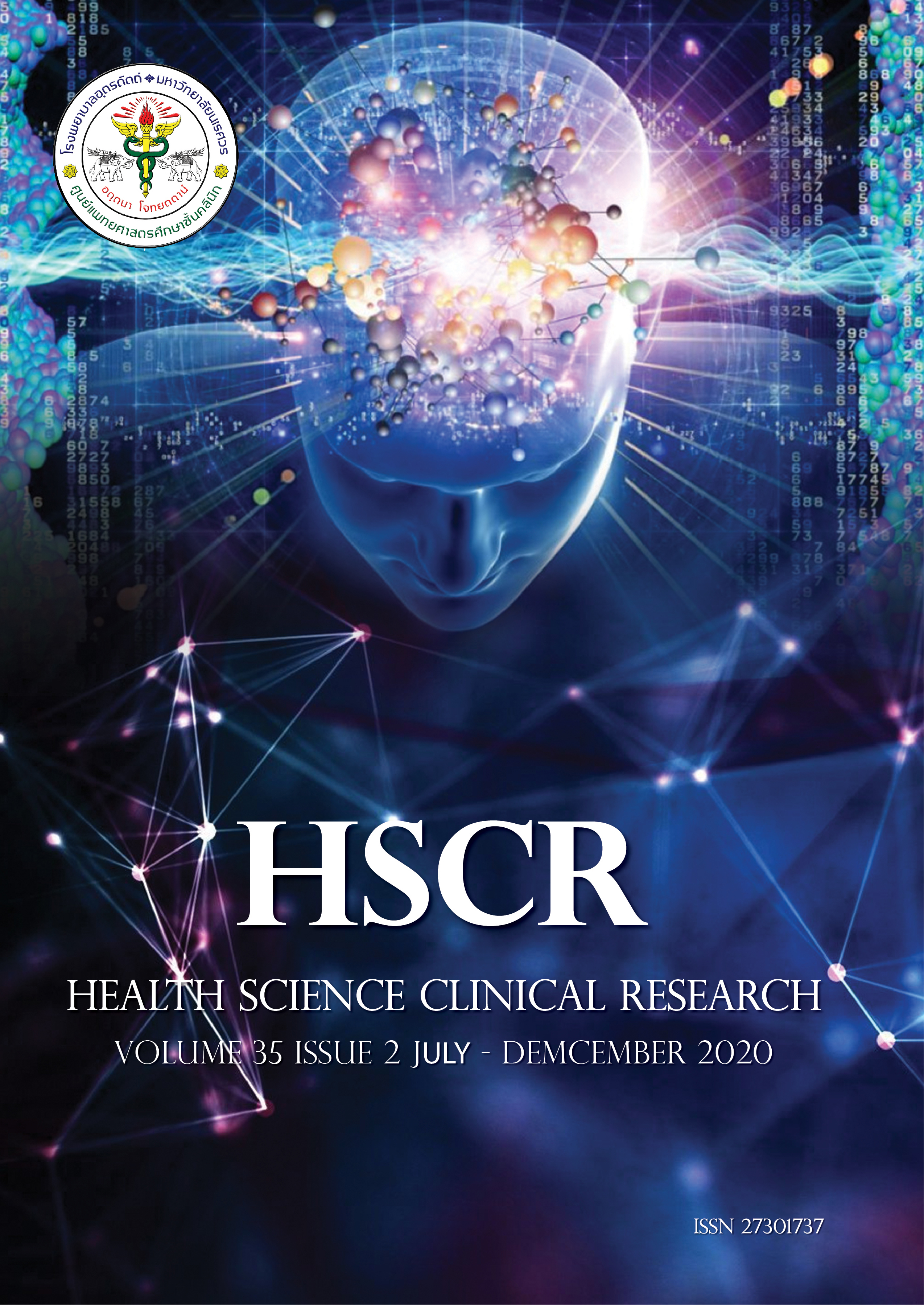SLE Patients with Melioidosis in Nongkhai Hospital
Keywords:
Melioidosis, Burkholderia pseudomallei, SLE, systemic lupus erythematosusAbstract
SLE is the autoimmune disease characterized by heterogeneous signs, symptoms and pathogenic
autoantibodies. In several studies, infection was the leading cause of morbidity and mortality in SLE
patients. Furthermore, infections in SLE patients can be difficult to distinguish from disease flare ups
while immunosuppressive drugs can change clinical manifestation of infection. Together, these latter
factors may lead to delay diagnosis. From recent metaanalysis study, the mortality rate due to infection
was found to be five times higher in SLE patients than in the general population. In addition, Melioidosis
is considered a major cause of community-acquired bacteremia in the Northeast patients (20%) and
resulting in a mortality of up to 50%. It can also present with a variety of clinical manifestations
especially abscess formation involving any organ. From the above reasons, we therefore collect case
series of SLE patients with melioidosis (which is a rare condition, difficult to diagnose, high morbidity
and mortality rate) in Nongkhai hospital between 2008-2020 compare with other studies. So we can
apply the results of this study for diagnostic and treatment planning in Nong Khai Hospital.
Results: 6 patients were all female with mean age (SD) 30.33 (2.57) years. Mean prednisolone dose
was 20.0 (6.19) mg. History used immunosuppressive drugs is observed in 33.30% and all cases received
antimalarial drugs. High grade of fever is observed in all cases but hepatitis was found only 50.0%.
Disease active involved urinary and hematological system is observed in 83.30%. All patients were
septicemia and sensitive to antibiotic drugs include ceftazidime, meropenem, and co-trimoxazole.
5 patients were cured (83.3%), 1 case was against advice and 1 case was relapse.
Conclusions: Melioidosis should be considered in SLE patients from the Northeast region, farmer
career and have underlying diseases such as diabetes, thalassemia. Since SLE is the autoimmune
disease which increased risk of infection especially gram-negative bacteria and melioidosis, therefore
we should consider ceftazidime or meropenem as first choice for empirical-broad spectrum antibiotic
drugs which sensitive to these organisms. Finally we suggest all SLE patients use antimalarial drug if no
contraindication.
Keywords: Melioidosis, Burkholderia pseudomallei, SLE, systemic lupus erythematosus
References
2. Michelle P. Infection in Systemic lupus ery¬thematosus. Rheum Dis Clin North Am 1998 May;24 (2):423-56.
3. Fessler, B. J. Infectious diseases in systemic lupus erythematosus: risk factors, management and prophylaxis.
Best Pract Res Clin Rheumatol 2002 Apr;16(2):281-91.
4. Emilio B, Juan GM, Patricia M. Infections in systemic lupus erythematosus and rheumatoid arthritis. Infect
Dis Clin North Am 2001 Jun;15(2):335-61.
5. Bouza E, Moya JG, Munoz P. Infections in systemic lupus erythematosus and rheumatoid arthritis. Infect Dis
Clin North Am. 2001; 15:335–61.
6. Ricard C, Munther AK, Josep F, et al. Morbidity and Mortality in Systemic Lupus Erythematosus During a
10-year Period: A Comparison of Early and Late Manifestations in a Cohort of 1,000 Patients. Medicine
(Baltimore) 2003 Sep;82(5):299-308.
7. Marko Y, Kateryna V, Wenjia C, et al. Overall and Cause-Specific Mortality in Patients with Systemic Lupus
Erythematosus: A Meta-Analysis of Observational Studies. Arthritis Care Res (Hoboken) 2014 Apr;66(4):608-16.
8. Ju-Yang J, Chang-Hee S. Infection in systemic lupus erythematosus, similarities, and differences with lupus
flare. Korean J Intern Med 2017; 32:429-438.
9. Sarah D, Harsh A, Erin B, et al. Infection and Lupus: Which Causes Which? Curr Rheumatol Rep 2016
Mar;18(3):13.
10. Cheng AC, Currie BJ. Melioidosis: epidemiology, pathophysiology, and management. Clin Microbiol Rev 2005
Apr;18(2):383-416.
11. Wooten MD, Panwalker AP. Septic arthritis caused by Burkholderia pseudomallei: case report and review
of the literature. J Clin Rheumatol 2001 Aug;7(4):242-7.
12. Currie BJ, Dance DA, Cheng AC. The global distribution of Burkholderia pseudomallei and melioidosis: an
update. Trans R Soc Trop Med Hyg 2008 Dec;102 Suppl 1: S1-4.
13. Chaowagul W, White NJ, Dance DA, Wattanagoon Y, Naigowit P, Davis TM, et al. Melioidosis: a major cause
of community-acquired septicemia in northeastern Thailand. J Infect Dis 1989 May; 159(5):890-9.
14. White NJ. Melioidosis. Lancet 2003 May 17;361(9370):1715-22.
15. Palasatien S, Lertsirivorakul R, Royros P, Wongratanacheewin S, Sermswan RW. Soil physicochemical properties
related to the presence of Burkholderia pseudomallei. Trans R Soc Trop Med Hyg 2008 Dec;102 Suppl 1: S5-9.
16. Lazdunski AM, Ventre I, Sturgis JN. Regulatory circuits and communication in Gram-negative bacteria.
Nat Rev Microbiol 2004 Jul;2(7):581-92.
17. Ulrich RL, Deshazer D, Brueggemann EE, Hines HB, Oyston PC, Jeddeloh JA. Role of quorum sensing in the
pathogenicity of Burkholderia pseudomallei. J Med Microbiol 2004 Nov;53(Pt 11):1053-64.
18. Wiersinga WJ, van der Poll T, White NJ, Day NP, Peacock SJ. Melioidosis: insights into the pathogenicity of
Burkholderia pseudomallei. Nat Rev Microbiol 2006 Apr;4(4):272-82.
19. Brett PJ, Woods DE. Pathogenesis of and immunity to melioidosis. Acta Trop 2000 Feb 5;74 (2-3):201-10.
20. Sarkar-Tyson M, Thwaite JE, Harding SV, Smither SJ, Oyston PC, Atkins TP, et al. Polysaccharides and
virulence of Burkholderia pseudomallei. J Med Microbiol 2007 Aug;56(Pt 8):1005-10.
21. Ekchariyawat P, Pudla S, Limposuwan K, Arjcharoen S, Sirisinha S, Utaisincharoen P. Burkholderia pseudomal
lei-induced expression of suppressor of cytokine signaling 3 and cytokine-inducible src homology 2-con
taining protein in mouse macrophages: a possible mechanism for suppression of the response to gamma
interferon stimulation. Infect Immun 2005 Nov;73(11):7332-9.
22. Haque A, Easton A, Smith D, O’Garra A, Van Rooijen N, Lertmemongkolchai G, et al. Role of T cells in innate
and adaptive immunity against murine Burkholderia pseudomallei infection. J Infect Dis 2006 Feb 1;193(3):370-9.
23. Dharakul T, Vejbaesya S, Chaowagul W, Luangtrakool P, Stephens HA, Songsivilai S. HLA-DR and –DQ asso
ciations with melioidosis. Hum Immunol 1998 Sep;59(9):580-6.
24. Brown NF, Boddey JA, Flegg CP, Beacham IR. Adherence of Burkholderia pseudomallei cells to cultured
human epithelial cell lines is regulated by growth temperature. Infect Immun 2002 Feb; 70(2):974-80.
25. Kespichayawattana W, Intachote P, Utaisincharoen P, Sirisinha S. Virulent Burkholderia pseudomallei is more
efficient than avirulent Burkholderia thailandensis in invasion of and adherence to cultured human epithelial
cells. Microb Pathog 2004 May;36(5):287-92.
26. Leelarasamee A. Recent development in melioidosis. Curr Opin Infect Dis 2004 Apr;17(2):131-6.
27. Pui MH, Tan AP. Musculoskeletal melioidosis: clinical and imaging features. Skeletal Radiol 1995 Oct;24(7):
499-503.
28. Raja NS. Melioidotic septic arthritis: a case report and literature review. J Microbiol Immunol Infect 2007
Apr;40(2):178-82.
29. Saengnipanthkul S, W, Kowsuwon W, Mahaisavariya B. Isolated articular melioidosis. Clin Orthop Relat
Laupattarakasem Res 1991 Jun; 267:182-5.
30. Thomas J, Jayachandran NV, Shenoy Chandrasekhara PK, Lakshmi V, Narsimulu G. Melioidosis-an unusual
cause of septic arthritis. Clin Rheumatol 2008 Dec;27 Suppl 2: S59-61.
31. Wiersinga WJ, van der Poll T. Immunity to Burkholderia pseudomallei. Curr Opin Infect Dis 2009 Apr;
22(2):102-8.
32. Nelson M, Prior JL, Lever MS, Jones HE, Atkins TP, Titball RW. Evaluation of lipopolysaccharide and capsular
polysaccharide as subunit vaccines against experimental melioidosis. J Med Microbiol 2004 Dec;53
(Pt 12):1177-82.
33. Dongying C, Jingyi X, Haihong C, et al. Infection in Southern Chinese patients with systemic lupus erythe
matosus: spectrum, drug resistance, outcomes, and risk factors. J Rheumatol 2016 Sep; 43(9):1650-6.
34. Christenson BB, Rodriguez JE, Vazquez G, et al. Pseudomonas Pseudomallei (Melioidosis): Acute septicemia
and meningitis in patient with systemic lupus erythematosus. Bol Asoc Med P R 1986 Aug;78(8):347-9.
35. Weerachai K, Twatchai T, Winia S, et al. Melioidotic septic arthritis and its risk factors. J Bone Joint Surg Am
2003 Jun;85(6):1058-61.
36. Badsha H, Edwards CJ, Chng HH. Melioidosis in systemic lupus erythematosus: The Importance of early
diagnosis and treatment in patients from endemic areas. Lupus 2001;10(11):821-3.
37. Vachvanichsanong P, Dissaneewate P, Prukprasert P, et al. Melioidosis and brain abscess in a girl with
systemic lupus erythematosus. Infect Dis Clin Pract 2002 May;11 (4):211-13.
38. Zakuan ZD, Habsah H, Mohd NSS. Clinical characteristics and outcomes of bacteraemic melioidosis in a
teaching hospital in a northeastern state of Malaysia: a five-year review. J Infect Dev Ctries 2010 Aug
4;4(7):430-5.
39. Irenawati S, Margaret CLW, Vui HC. Intracerebral Coinfection with Burkholderia Pseudomallei and Cryptococcus
Neoformans in a Patient with Systemic Lupus Erythematosus. Southeast Asian J Trop Med Public Health
2014 March;45(2):352-6.
40. Ulcerating abscess in a case of systemic lupus erythematosus (SLE) due to Burkholderia pseudomallei -
a case report. Arch of Clin Micro 2015 October;7(1:2):1-4.
41. Danza A, Ruiz IG. Infection risk in systemic lupus erythematosus patients: susceptibility factors and preventive
strategies. Lupus. 2013 Oct;22(12):1286-94.
42. Tsai PH, Jang SS, Liou LB. Septicaemia is associated with increased disease activity and mortality in systemic
lupus erythematosus: a retrospective analysis from Taiwan. Lupus. 2020 Feb;29(2):191-198.
43. Irastorza GR, Olivares N, Arruza IR, et al. Predictors of Major Infections in Systemic Lupus Erythematosus.
Arthritis Res Ther 2009;11(4): R109.
44. Sisó A, Ramos CM, Bóve A, ET AL. Previous antimalarial therapy in patients diagnosed with lupus nephritis:
Influence on outcomes and survival. Lupus 2008 Apr;17(4):281-8.
Downloads
Published
How to Cite
Issue
Section
License
The names and email addresses entered in this journal site will be used exclusively for the stated purposes of this journal and will not be made available for any other purpose or to any other party.











